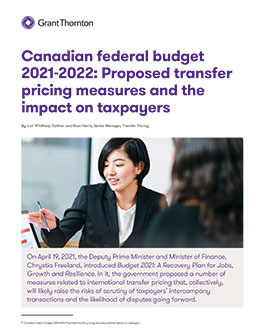In April 2021, the Canadian government unveiled Budget 2021—and, in it, a host of measures related to international transfer pricing. The government’s new approach to transfer pricing is based on 15 recommendations issued by the Organisation for Economic Cooperation and Development, whose Base Erosion and Profit Shifting initiative strives to crack down on business tax avoidance. As a result, these measures will likely dramatically impact taxpayers in the future.
In this article, we summarize the key transfer pricing changes we believe will most affect Canadian taxpayers and offer insights into what these taxpayers can expect moving forward. Specifically, we discuss:
- Changes to transfer pricing rules, and what the government’s proposed amendments could end up looking like.
- New interest deductibility limits, including what they’ll entail and who they’ll target.
- Hybrid mismatch rules and how they could deny some taxpayers significant tax benefits.
- New mandatory disclosure rules around reportable transactions, notifiable transactions and uncertain tax positions—and how this could lead to an influx of CRA audits.
- Enforcement policy changes, specifically leaving the door open for audits if taxpayers don’t disclose suspicious transactions or arrangements under the new disclosure regime.
- More intensive tax audit procedures, which could result in managers and employees submitting to verbal questioning by CRA auditors.
Download the PDF
Read the Canadian federal budget 2021-2022: Proposed transfer pricing measures and the impact on taxpayers here.











